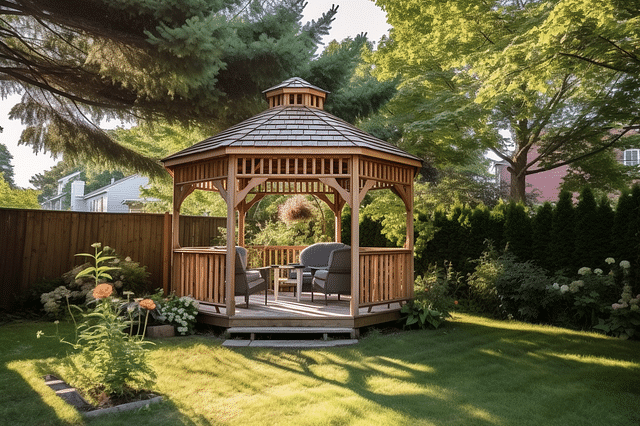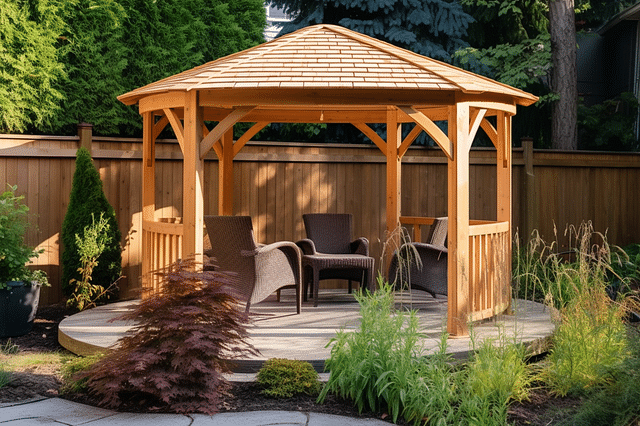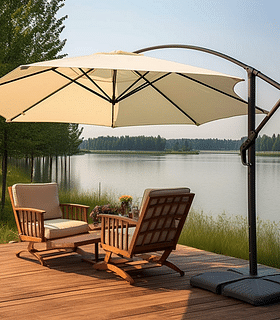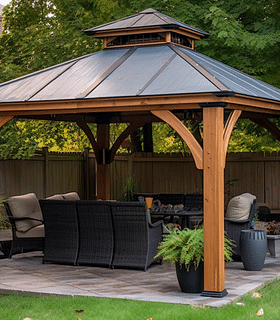How to anchor a gazebo without drilling and protect your property
Discover how to anchor a gazebo without drilling and protect your property. Learn effective methods and tips in our latest blog post. Safeguard your outdoor space now!

Have you ever wanted to set up a gazebo in your yard but hesitated because you didn't want to drill into the ground and risk damaging your property? Well, you're not alone. Many people face this dilemma when it comes to anchoring their gazebos.
In this blog post, we will explore a simple and effective solution on how to anchor a gazebo without drilling into the ground. Not only will this method save you time and effort, but it will also ensure the safety and stability of your gazebo.
So, whether you have a special event coming up or simply want to create a cozy outdoor living space, keep reading to discover how you can anchor your gazebo without drilling and protect your property at the same time.
Why is it important to anchor a gazebo?
When setting up a gazebo in your yard, it is essential to properly anchor it to the ground. Anchoring a gazebo provides stability and ensures that it remains secure even during strong winds or adverse weather conditions. In this section, we will explore the risks of an unanchored gazebo and how anchoring can protect your property.
What are the risks of an unanchored gazebo?
An unanchored gazebo can pose several risks, especially when faced with unpredictable weather or strong winds. Here are some potential dangers of not properly securing your gazebo:
Structural instability: Without proper anchoring, a gazebo is susceptible to instability. As it stands loosely on the ground, it can easily sway, tilt, or even collapse, potentially causing injury to anyone nearby or damage to surrounding structures.
Wind damage: One of the main risks of an unanchored gazebo is its vulnerability to high winds. Gusts of wind can exert immense pressure on the gazebo, causing it to lift off the ground or get blown away. This can lead to significant damage to not only the gazebo itself but also other objects in its path.
Property damage: An unanchored gazebo can become a projectile, posing a threat to your property and even neighboring properties. It can crash into your house, vehicles, fences, or other valuable assets, resulting in expensive repairs or replacements.
Personal safety hazards: Without proper anchoring, a gazebo can present safety hazards to you, your family, and your guests. In the event of sudden strong winds, an unanchored gazebo may collapse or be displaced, potentially causing injuries to those nearby.
How can anchoring a gazebo protect your property?
Anchoring a gazebo is a crucial step in ensuring the safety of your property and those who enjoy spending time in your outdoor space. Here's how anchoring can protect your property:
Enhanced stability: By securely anchoring your gazebo, you increase its stability and decrease the chances of it toppling over or shifting during inclement weather. This provides peace of mind, knowing that your gazebo will remain securely in place, even during strong winds or heavy rain.
Prevention of wind damage: Anchoring a gazebo properly can significantly reduce the risk of wind damage. The anchors, which are typically secured to the ground or concrete, help keep the gazebo firmly in position, preventing it from getting lifted by strong gusts of wind. This safeguard ensures that both the gazebo and surrounding property are protected from potential destruction.
Protection of property and assets: By anchoring your gazebo, you can prevent it from becoming a hazardous projectile that can cause damage to your property or neighboring properties. Securing the gazebo in place eliminates the risk of it crashing into buildings, vehicles, or other valuable assets during severe weather conditions.
Safety for everyone: When a gazebo is properly anchored, it creates a safe environment for you, your family, and your guests. You can enjoy gatherings, relaxation, and outdoor activities without worrying about the gazebo collapsing or being blown away unexpectedly.
In conclusion, the act of anchoring a gazebo is not just a matter of ensuring its stability, but also a crucial step in protecting your property, assets, and the safety of everyone in your outdoor space. By taking the necessary precautions, you can enjoy your gazebo, worry-free, knowing that it is securely anchored and able to withstand various weather conditions.
Methods for anchoring a gazebo without drilling

When it comes to securing a gazebo in place, many people opt for methods that do not involve drilling into the ground. Whether you are setting up a temporary structure or have restrictions on drilling in your outdoor space, there are several effective options available. In this section, we will explore three popular methods for anchoring a gazebo without the need for drilling: using sandbags or weights, using ground screws or anchors, and using concrete blocks or paving stones.
Using sandbags or weights
One straightforward method for anchoring a gazebo is by using sandbags or weights. This option is particularly useful for temporary setups or locations where drilling is not possible or desired. To use this method, you will need sandbags or weights specifically designed for outdoor use.
- Begin by placing sandbags or weights around the perimeter of the gazebo. Ensure that they are evenly spaced and positioned on all sides.
- Depending on the size and weight of your gazebo, you may need multiple sandbags or weights for each side. Consider the weight of the gazebo and the level of stability required.
- Once the sandbags or weights are in place, ensure that they are secured tightly and cannot be easily moved. This will help to prevent any shifting or tipping of the gazebo during windy conditions.
- Regularly inspect the sandbags or weights and make adjustments as needed to maintain the stability of the gazebo.
Using ground screws or anchors
Another effective method for anchoring a gazebo without drilling is by using ground screws or anchors. These are sturdy and secure options that provide stability even in challenging weather conditions.
- Start by selecting the appropriate ground screws or anchors based on the size and weight of your gazebo. Consider the type of soil in your outdoor space to ensure compatibility.
- Using a mallet or hammer, drive the ground screws or anchors into the ground at each corner of the gazebo. Make sure they are firmly embedded and level with the ground.
- Attach the gazebo legs or base to the ground screws or anchors using the provided hardware or straps. Follow the manufacturer's instructions for proper installation.
- Once the gazebo is attached, check for any wobbling or instability. If necessary, adjust the ground screws or anchors to ensure a secure and level setup.
- Periodically inspect the ground screws or anchors and tighten them if needed to maintain the stability of the gazebo.
Using concrete blocks or paving stones
Concrete blocks or paving stones are another reliable option for anchoring a gazebo without drilling. This method provides a solid and stable foundation while allowing for easy disassembly and repositioning if needed.
- Begin by placing concrete blocks or paving stones at each corner of the gazebo. Ensure that they are level and secure on the ground.
- Place additional concrete blocks or paving stones along the sides and center of the gazebo for added stability.
- Carefully position the gazebo legs or base on top of the concrete blocks or paving stones, ensuring that they are aligned and balanced.
- If desired, use adhesive or straps to further secure the gazebo to the concrete blocks or paving stones.
- Regularly inspect the concrete blocks or paving stones and make adjustments if necessary to maintain the stability of the gazebo.
By using sandbags or weights, ground screws or anchors, or concrete blocks or paving stones, you can securely anchor your gazebo without the need for drilling. Choose the method that best suits your needs and enjoy a stable and enjoyable outdoor space.
Tips for effective gazebo anchoring

Gazebos are a beautiful addition to any outdoor space, providing shade and a cozy spot to relax. However, in order to ensure the safety and stability of your gazebo, proper anchoring is essential. Here are some tips to help you anchor your gazebo effectively:
Choosing the right anchor type for your gazebo
The first step in effective gazebo anchoring is to choose the right anchor type for your specific gazebo. There are several anchor options available, including ground stakes, auger anchors, and concrete footings.
Ground stakes are a commonly used anchor option and work well for gazebos that are placed on soft ground. They are typically made of steel or iron and penetrate the ground to provide stability. Auger anchors, on the other hand, are corkscrew-shaped and twist into the ground, providing a secure hold. These anchors are ideal for gazebos placed on grass or soil.
If you have a permanent gazebo or live in an area with high winds or soft soil, you may want to consider using concrete footings. This involves pouring concrete into the ground and installing anchor bolts to secure the gazebo.
When choosing the right anchor type for your gazebo, consider factors such as the size and weight of the gazebo, the type of soil in your area, and the climate conditions that your gazebo will be exposed to. Consulting with a professional can help you make the best decision for your specific needs.
Ensuring proper placement and spacing of anchors
Once you've chosen the right anchor type, it's important to ensure proper placement and spacing of the anchors. The goal is to distribute the weight of the gazebo evenly and provide stability.
Start by determining the number of anchors needed for your gazebo. This will depend on the size and weight of your gazebo, as well as any local building codes or regulations. As a general rule, it's recommended to have at least one anchor per corner of the gazebo.
Next, carefully measure and mark the desired anchor locations. It's important to ensure that the anchors are placed in a straight line and at equal distances from each other. This will help prevent any uneven stress on the gazebo and maintain its stability.
When placing the anchors, make sure they are inserted securely into the ground or concrete footing. They should be driven in until they are flush with the ground or the top of the concrete footing, depending on the anchor type. It's also important to check that the anchors are aligned vertically and not leaning in any direction.
Regular maintenance and inspection
Once your gazebo is properly anchored, it's important to regularly maintain and inspect the anchors to ensure their effectiveness. Over time, anchors may loosen or deteriorate due to various factors such as weather conditions, soil erosion, or natural wear and tear.
Regularly inspect the anchors for any signs of damage, rust, or movement. If you notice any issues, it's important to address them promptly. Tighten any loose anchors and replace any damaged or corroded anchors as soon as possible.
In addition to regular inspections, it's also a good idea to periodically check the overall stability of your gazebo. Look for any signs of wobbling, leaning, or shifting. If you notice any stability issues, it may be necessary to reinforce or replace the existing anchors.
By choosing the right anchor type, ensuring proper placement and spacing, and regularly maintaining and inspecting your gazebo anchors, you can enjoy a safe and stable outdoor retreat for years to come.
Trending products
Shop outdoor accessoriesFrequently asked questions
- How can I anchor a gazebo without drilling?
- There are alternative methods to anchor a gazebo without drilling, such as using weighted base plates, sandbags, or concrete blocks. These options provide stability without the need for permanent drilling.
- Will these methods protect my property?
- Yes, these methods will help protect your property. By securely anchoring your gazebo, you can prevent it from toppling over during strong winds or storms, minimizing potential damage to your property and ensuring everyone's safety.
- Are weighted base plates a good option for anchoring a gazebo?
- Weighted base plates are a great option for anchoring a gazebo without drilling. These plates can be filled with sand or water to provide stability and can easily be removed when necessary.
- How do sandbags help in anchoring a gazebo?
- Sandbags are an effective way to anchor a gazebo. They can be strategically placed around the gazebo's legs and filled with sand, providing the necessary weight and stability to keep it securely in place.
- Can I use concrete blocks to anchor a gazebo without drilling?
- Concrete blocks are a reliable option for anchoring a gazebo without drilling. Simply place the blocks near the gazebo's legs and ensure they are in contact with the ground for added stability.
- How do I ensure the gazebo is securely anchored using these methods?
- To ensure your gazebo is securely anchored, make sure to follow the manufacturer's instructions and recommendations for the chosen method. Regularly inspect the anchoring system to ensure it remains stable and make any necessary adjustments.
- Can these methods be used for all types of gazebos?
- Yes, these methods can be used for most types of gazebos. Whether you have a pop-up gazebo, a permanent structure, or a portable one, you can find suitable anchoring options that do not require drilling.
- Are there any limitations to anchoring a gazebo without drilling?
- While these alternative methods provide stability, it's important to consider the specific weather conditions in your area. In extremely windy regions or during severe storms, additional measures may be required to ensure the gazebo's stability.
- Can I easily remove the anchoring system when needed?
- Yes, most non-drilling anchoring options can be easily removed when needed. This flexibility allows you to relocate or store your gazebo without leaving any permanent marks or damage on your property.
- Are there any additional tips to ensure the gazebo's stability?
- Along with using non-drilling anchoring methods, it's advisable to take other precautions for added stability, such as using guy ropes or investing in sturdy gazebo frame materials. Regular maintenance and inspections will also help ensure your gazebo remains securely anchored over time.
Are you looking for more ideas?
Have a look at these other guides about improving your garden and patio to create your dream outdoor space!

Are you looking for more ideas?
-
- Role
- Best Riding Lawn Mowers for Hills: Your Ultimate Guide to Slope-Friendly Mowing
- Description
- Explore our comprehensive guide to the best riding lawn mowers for hills. Get insights into top picks, mowing techniques, and FAQs to maintain a perfect lawn on hilly terrains.
-
- Role
- The Best Snake Repellent: A Comprehensive Review
- Description
- Discover the best snake repellents for your garden in our comprehensive guide. Understand how they work, their safety, and application frequency. Secure your outdoor space from unwanted snake visits today!
-
- Role
- Preventing and Removing Rust from Outdoor Metal Furniture
- Description
- Discover the best zero turn mowers for hilly terrains in our comprehensive review. Find out why these mowers excel on slopes and get safety tips for optimal use. Upgrade your lawn care today!
-
- Role
- What size posts should you use for driveway gates?
- Description
- Discover the best size posts for driveway gates. Find out how to choose the right posts for your driveway gates and ensure a secure and functional installation.



